Development of a Flexible Strain Sensor Based on PEDOT:PSS for Thin Film Structures
Abstract
:1. Introduction
2. Materials and Methods
2.1. Materials
2.1.1. Sensor Substrate
2.1.2. Conductive Filler
2.1.3. Matrix
2.1.4. Protection of the Sensor and Connecting Wires
2.2. Preparation of the Sensor
- Preparation of aqueous dispersions (silicone and PEDOT:PSS);
- Preparation of the substrate;
- Deposition of the conductive layer;
- Deposition of the connecting wires; and
- Deposition of a protective silicone layer.
2.2.1. Preparation of Aqueous Dispersions (Silicone and PEDOT:PSS)
2.2.2. Preparation of the Substrate
2.2.3. Deposition of the Conductive Layer
2.2.4. Deposition of the Connecting Wires
2.2.5. Deposition of a Protective Silicone Layer
- -
- As a chemically inert and waterproof material, it may protect the conductive coating from the harsh outside environment (especially from UV radiation);
- -
- It may reinforce the adhesion properties of the coating on the substrates;
- -
- Due to the overall dark blue color of the coating, the sensor may heat when exposed to direct sunlight (because of IR absorption), leading to signal interferences (because of exceeding dilatation), or advanced ageing. As the chosen sealant silicone was white, it also may lower the sun’s influence on sensor performance.
2.3. Test Methods for the Characterization of Prepared Sensor
2.3.1. Electrical Resistance of the PEDOT:PSS/Silicone Coatings
2.3.2. Mechanical Characterization
- -
- Initial distance of the jaws: 200 mm
- -
- Speed of the jaws: 100 mm/min
- -
- Preload: 0 N
- -
- Initial distance of the jaws: 200 mm
- -
- Speed of the jaws: 100 mm/min
- -
- Preload: 0 N
2.3.3. Electromechanical Characterization of the Sensor
3. Results and Discussion
3.1. Conductivity of the PEDOT:PSS/Silicone Coatings
3.2. Response of the Sensors to Mechanical Strain
3.2.1. Validation of the Global Flexibility
3.2.2. Validation of the Yarn Connection
3.3. Electromechanical Characterization of the Sensors
4. Conclusions
Acknowledgments
Author Contributions
Conflicts of Interest
References
- Schweizer, T.M. Electrical Characterization and Investigation of the Piezoresistive Effect of PEDOT: PSS Thin Films; Georgia Institute of Technology: Atlanta, GA, USA, 19 April 2005. [Google Scholar]
- Cochrane, C.; Koncar, V.; Lewandowski, M.; Dufour, C. Design and development of a flexible strain sensor for textile structures based on a conductive polymer composite. Sensors 2007, 7, 473–492. [Google Scholar] [CrossRef]
- Chang, C.-L.; Fix, K.; Wang, W.-C. Reliability of PEDOT-PSS Strain Gauge on Foam Structure. Proc. SPIE Int. Soc. Opt. Eng. 2010, 7646, 764616–764618. [Google Scholar]
- Ouyang, J.; Chu, C.; Chen, F.; Xu, Q.; Yang, Y. Polymer Optoelectronic Devices with High-Conductivity Poly(3,4-Ethylenedioxythiophene) Anodes. J. Macromol. Sci. Part A 2004, 41, 1497–1511. [Google Scholar] [CrossRef]
- Wang, P.-C.; Liu, L.-H.; Alemu Mengistie, D.; Li, K.-H.; Wen, B.-J.; Liu, T.-S.; Chu, C.-W. Transparent Electrodes Based on Conducting Polymers for Display Applications. Displays 2013, 34, 301–314. [Google Scholar] [CrossRef]
- Cochrane, C.; Koncar, V.; Lewandowski, M. Development of a Flexible Strain Sensor for Textile Structures. In Proceedings of the Ambience 08 International Scientific Conference, Boras, Sweden, 2–3 June 2008. [Google Scholar]
- Trifigny, N.; Kelly, F.M.; Cochrane, C.; Boussu, F.; Koncar, V.; Soulat, D. PEDOT:PSS-Based Piezo-Resistive Sensors Applied to Reinforcement Glass Fibres for in Situ Measurement during the Composite Material Weaving Process. Sensors 2013, 13, 10749–10764. [Google Scholar] [CrossRef] [PubMed]
- Akerfeldt, M.; Straat, M.; Walkenström, P. Electrically Conductive Textile Coating with a PEDOT-PSS Dispersion and a Polyurethane Binder. Text. Res. J. 2012, 83, 618–627. [Google Scholar] [CrossRef]
- Trifigny, N.; Kelly, F.M.; Cochrane, C.; Boussu, F.; Koncar, V.; Soulat, D. PEDOT:PSS Sensors for In-Situ Measurement during the Composite Material Weaving Process. In Proceedings of the 13th AUTEX World Textile Conference, Dresden, Germany, 22–24 May 2013; pp. 1–7. [Google Scholar]
- Sun, J.; Gerberich, W.W.; Francis, L.F. Transparent, Conductive Coatings from Latex-Based Dispersions. In Proceedings of the 12th International Coating Science and Technology Symposium, Rochester, NY, USA, 23–25 September 2004; pp. 184–185. [Google Scholar]
- Bashir, T.; Ali, M.; Persson, N.-K.; Ramamoorthy, S.K.; Skrifvars, M. Stretch Sensing Properties of Conductive Knitted Structures of PEDOT-Coated Viscose and Polyester Yarns. Text. Res. J. 2014, 84, 323–334. [Google Scholar] [CrossRef]
- Toprakci, H.A.K.; Ghosh, T.K. Textile Sensors. In Handbook of Smart Textiles; Tao, X., Ed.; Springer: Singapore, 2015; pp. 357–379. [Google Scholar]
- Lorussi, F.; Rocchia, W.; Scilingo, E.P.; Tognetti, A.; De Rossi, D. Wearable, Redundant Fabric-Based Sensor Arrays for Reconstruction of Body Segment Posture. IEEE Sens. J. 2004, 4, 807–818. [Google Scholar] [CrossRef]
- Lorussi, F.; Scilingo, E.P.; Tesconi, M.; Tognetti, A.; De Rossi, D. Strain Sensing Fabric for Hand Posture and Gesture Monitoring. IEEE Trans. Inf. Technol. Biomed. 2005, 9, 372–381. [Google Scholar] [CrossRef] [PubMed]
- Calvert, P.; Patra, P.; Lo, T.; Chen, C. Piezoresistive Sensors for Smart Textiles. In Proceedings of the SPIE Electroactive Polymer Actuators and Devices, San Diego, CA, USA, 18 March 2007. [Google Scholar]
- Gibbs, P.; Asada, H.H. Wearable Conductive Fiber Sensors for Measuring Joint Movements. In Proceedings of the IEEE International Conference on Robotics and Automation, New Orleans, LA, USA, 26 April–1 May 2004. [Google Scholar]
- Asch, G. Les Capteurs en Instrumentation Industrielle, 7th ed.; Dunod: Paris, France, 2016. [Google Scholar]
- Rausch, J. Printed Piezoresistive Strain Sensors for Monitoring of Light-Weight Structures. In Proceedings of the SENSOR & TEST Conference, Nürnberg, Germany, 7–9 June 2011; pp. 216–221. [Google Scholar]
- Latessa, G.; Brunetti, F.; Reale, A.; Saggio, G.; Di Carlo, A. Piezoresistive Behaviour of Flexible PEDOT:PSS Based Sensors. Sens. Actuators B Chem. 2009, 139, 304–309. [Google Scholar] [CrossRef]
- Fung, C.K.M.; Zhang, M.Q.H.; Chan, R.H.M.; Li, W.J. A PMMA-Based Micro Pressure Sensor Chip Using Carbon Nanotubes as Sensing Elements. In Proceedings of the 18th IEEE International Conference on Micro Electro Mechanical Systems, Miami Beach, FL, USA, 30 January–3 February 2005; pp. 251–254. [Google Scholar]
- Perc, B.; Kuš, D.; Holc, J.; Belavi, D.; Jerlah, M.; Svetec, G.; Kosec, M. Thick-Film Strain Sensor on Textile. Available online: http://microflex.ecs.soton.ac.uk/externaldocs/Perc_midem_2009_11.pdf (accessed on 8 June 2017).
- Heraeus Company. Coating Guide Clevios P Formulations, Issue 10, Heraeus, Hanau, Germany. Available online: http://heraeus-clevios.com (accessed on 10 November 2013).
- Sun, J.; Gerberich, W.; Francis, L. Transparent, Conductive Polymer Blend Coatings from Latex-Based Dispersions. Prog. Org. Coat. 2007, 59, 115–121. [Google Scholar] [CrossRef]
- Cochrane, C.; Lewandowski, M.; Koncar, V. A Flexible Strain Sensor Based on a Conductive Polymer Composite for In Situ Measurement of Parachute Canopy Deformation. Sensors 2010, 10, 8291–8303. [Google Scholar] [CrossRef] [PubMed]
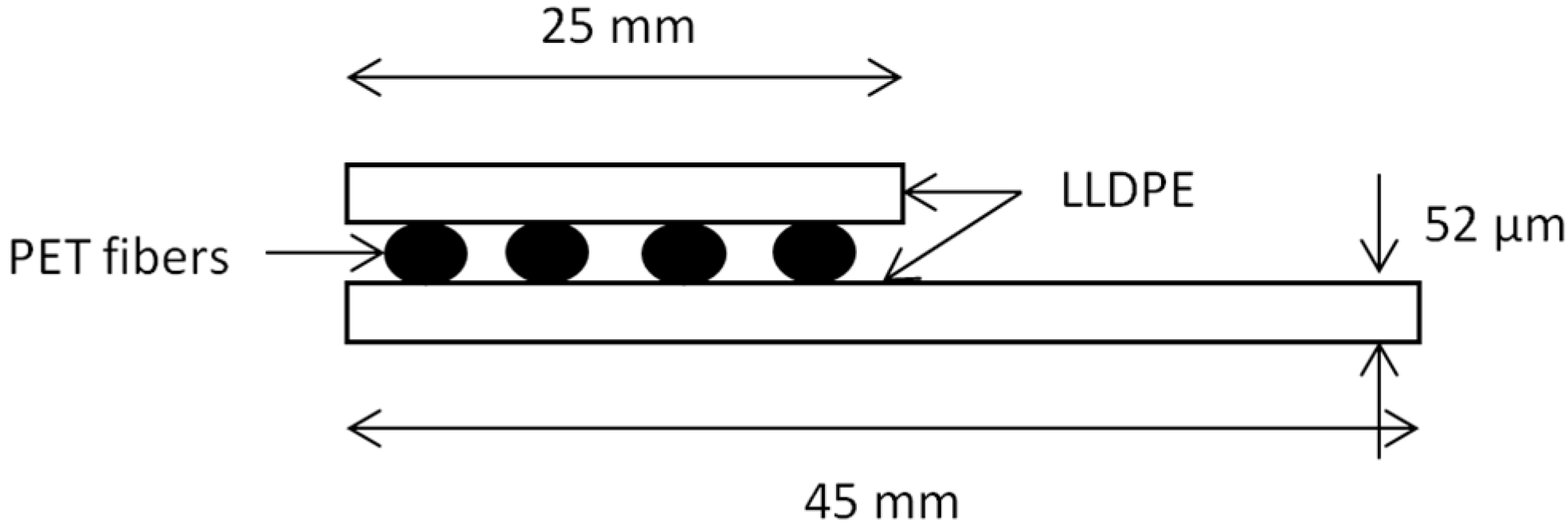
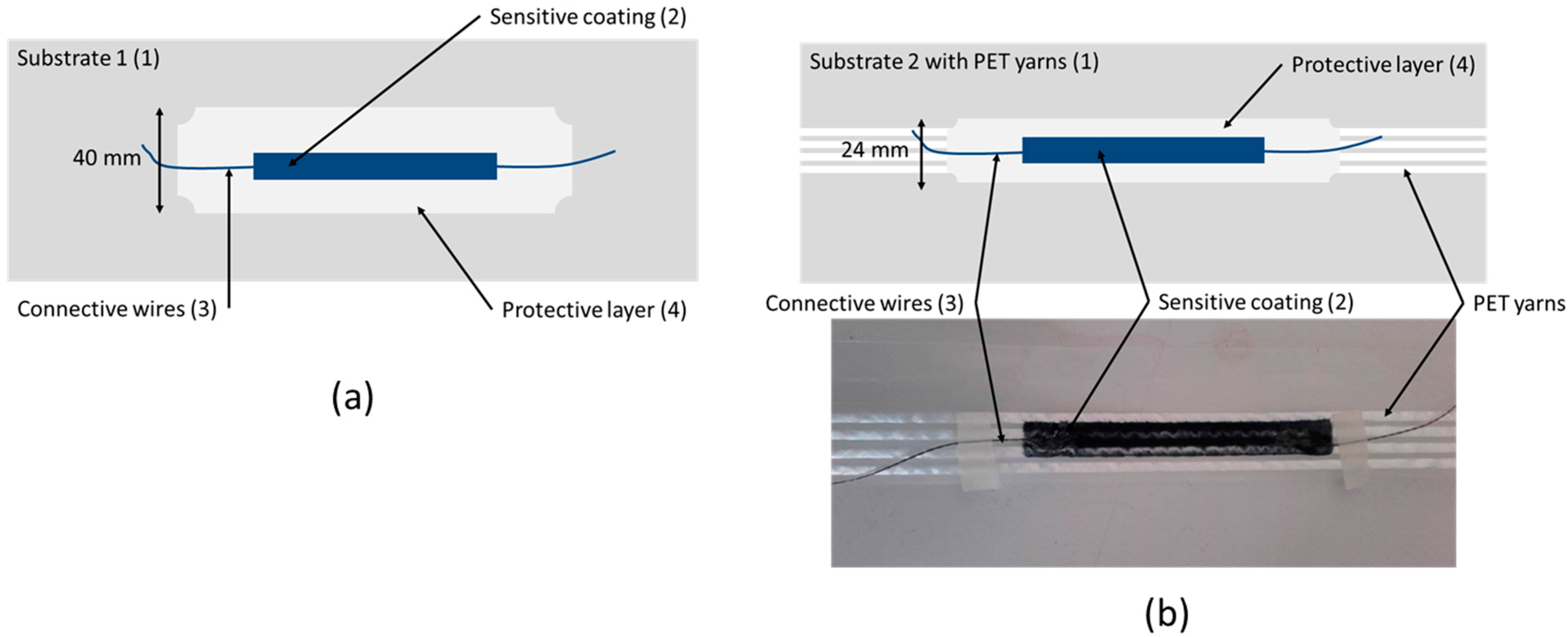
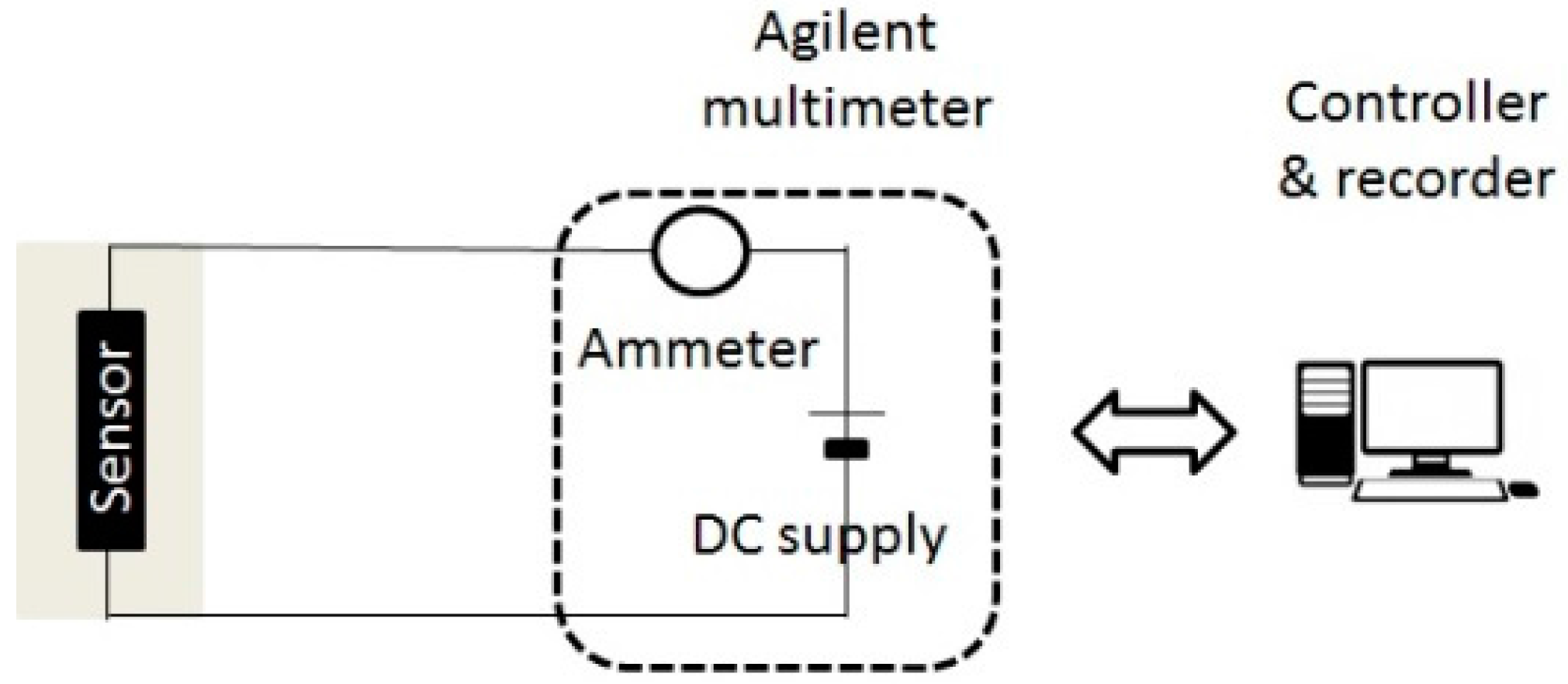
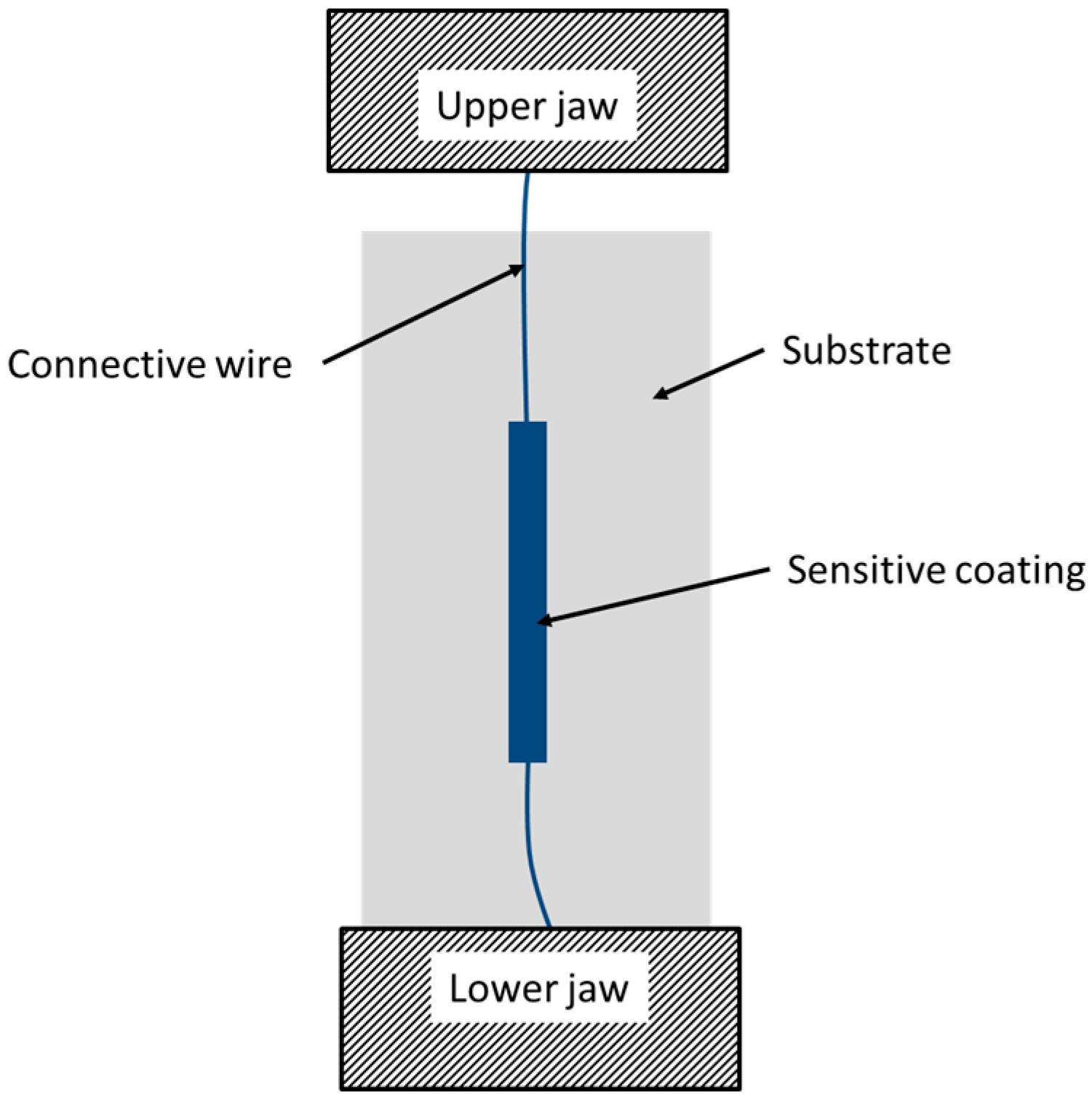
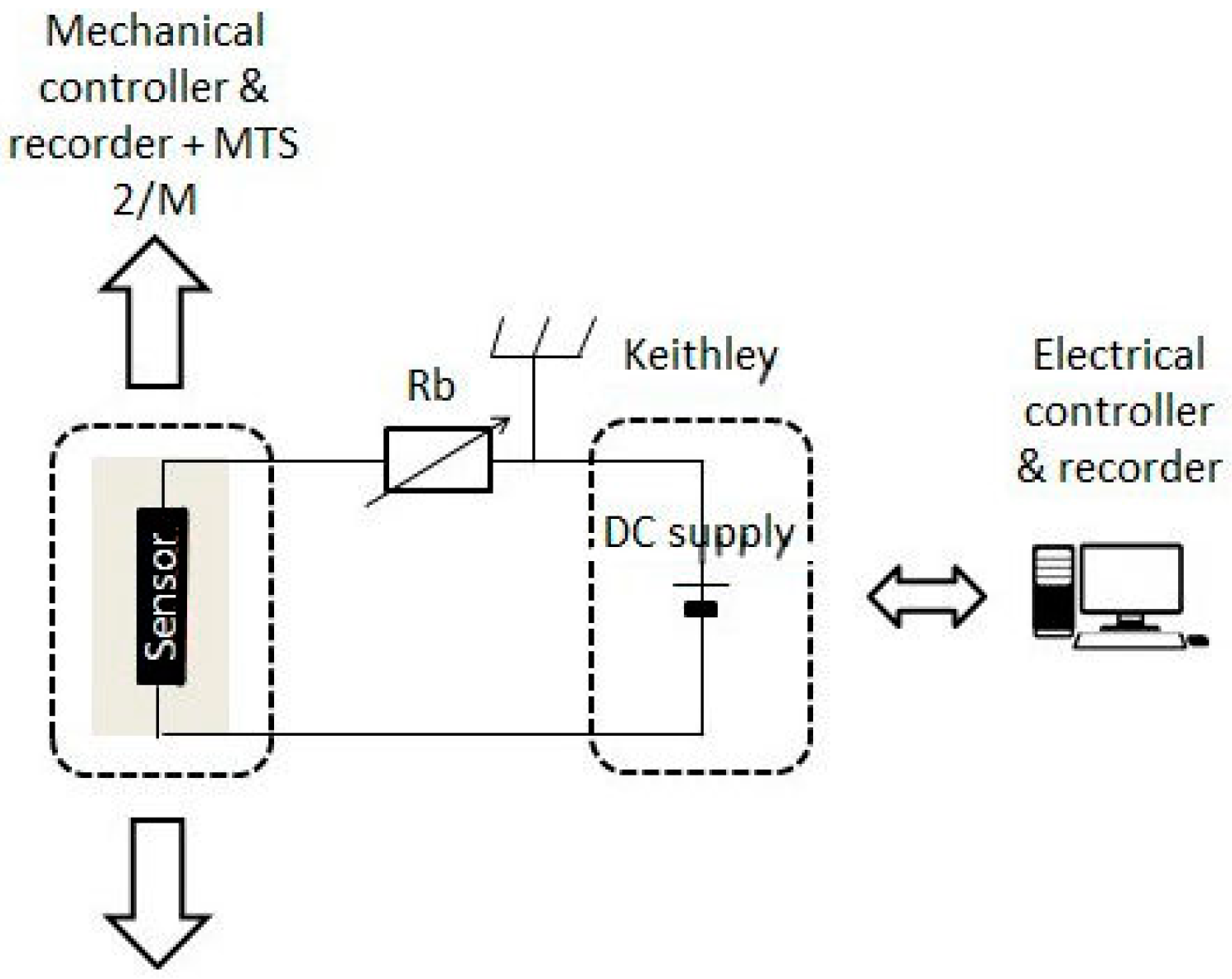
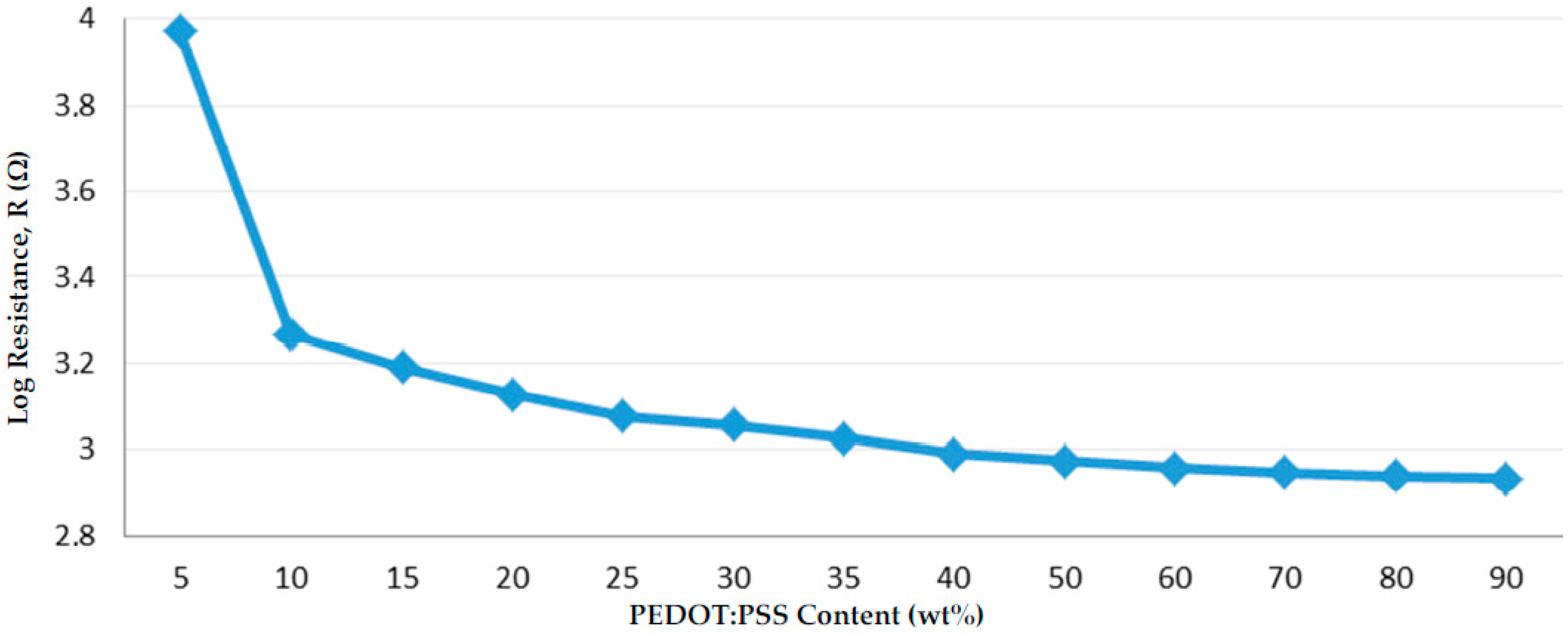

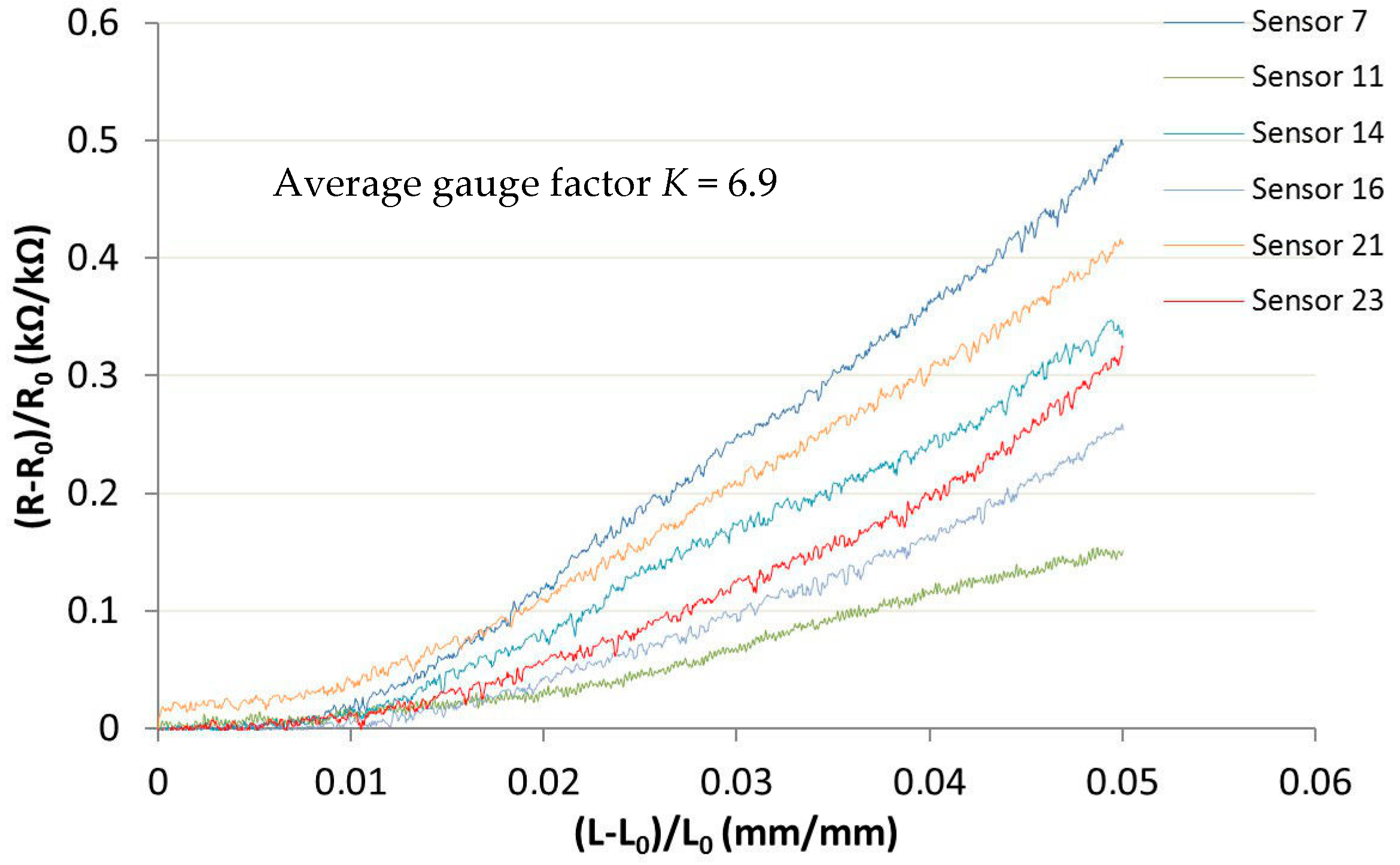
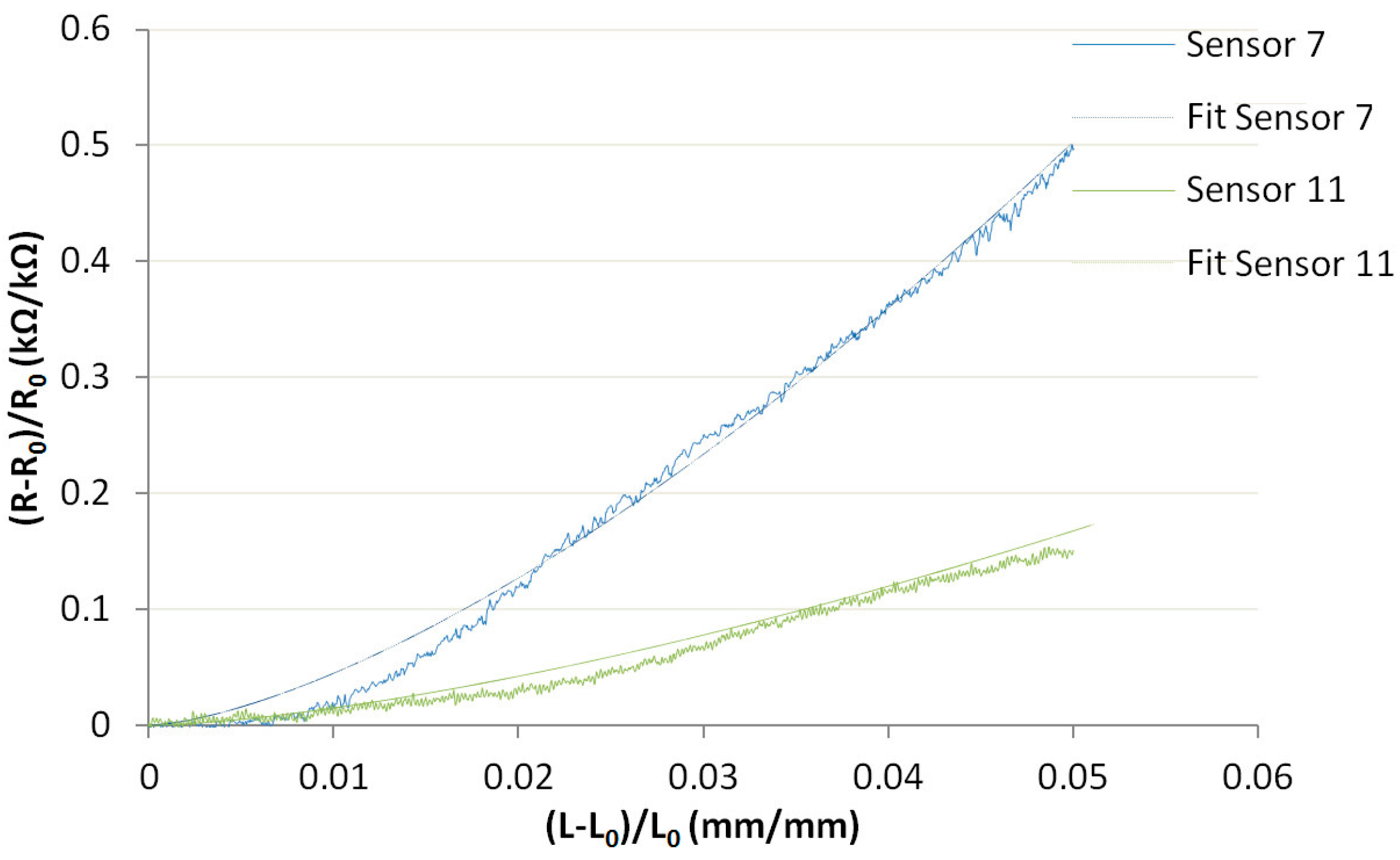
| Materials | Gauge Factor (K) | Application |
|---|---|---|
| Gold [1] | 2.1 | Traditional strain gauge |
| Copper [1] | 2.2 | Traditional strain gauge |
| Platinum [1] | 4.0 | Traditional strain gauge |
| Constantan or Karma [16] | 2.1 | Alloys for metallic strain gauge |
| Nichrome V [16] | 2.5 | Alloy for metallic strain gauge |
| Isoelastic [16] | 3.5 | Alloy for metallic strain gauge |
| Platinum-Tungsten [16] | 4.1 | Alloy for metallic strain gauge |
| Silver [17] | 3.35 | Ink used for strain sensor applied by aerosol jet |
| Commercial semi-conductors [16] | 45–175 | Strain gauge |
| PEDOT:PSS [17] | 0.48 | Ink used for strain sensor applied by coating |
| PEDOT:PSS [18] | 17.8 ± 4 | Electrochemical synthesis of a PEDOT:PSS thin film deposited on a textile substrate |
| PMMA-MWCNT Composite [17] | 15.32 | Ink used for strain sensor made by hot pressing |
| PMMA-MWCNT Composite [1,19] | 235 | Micro pressure sensor chip |
| Carbon black-Evoprene [2] | 80 | Strain gauge on textile substrate |
| ESL/Silver + graphite pastes [20] | ≈5 | Thick film strain sensors using screen-printing technique |
| Component | % By Weight |
|---|---|
| CleviosTM F010 | 42.92 |
| N-Methyl-2-pyrrolidinone | 2.58 |
| Sliquest® A 187TM | 0.86 |
| Isopropanol | 53.34 |
| DynolTM 604 | 0.30 |
| Total | 100.00 |
| Sample Number | Description of the Sample | Dimension of the Protective Layer (Length × Width) | Total Number of Tested Samples |
|---|---|---|---|
| S-0 | Substrate 1 used as reference | Without protective layer | 4 |
| S-20 | Substrate 1 + protective layer | 130 mm × 20 mm | 4 |
| S-24 | Substrate 1 + protective layer | 130 mm × 24 mm | 4 |
| S-30 | Substrate 1 + protective layer | 130 mm × 30 mm | 4 |
| S-40 | Substrate 1 + protective layer | 130 mm × 40 mm | 4 |
| S-50 | Substrate 1 + protective layer | 130 mm × 50 mm | 4 |
| SP-40 | Plasma treated substrate 1 + protective layer | 130 mm × 40 mm | 4 |
| Force at Break Average (N) | Force at Break Minimum (N) | Standard Deviation | CV % | Samples Number |
|---|---|---|---|---|
| 19.00 | 15.13 | 2.83 | 15 | 9 |
© 2017 by the authors. Licensee MDPI, Basel, Switzerland. This article is an open access article distributed under the terms and conditions of the Creative Commons Attribution (CC BY) license (http://creativecommons.org/licenses/by/4.0/).
Share and Cite
El Zein, A.; Huppé, C.; Cochrane, C. Development of a Flexible Strain Sensor Based on PEDOT:PSS for Thin Film Structures. Sensors 2017, 17, 1337. https://doi.org/10.3390/s17061337
El Zein A, Huppé C, Cochrane C. Development of a Flexible Strain Sensor Based on PEDOT:PSS for Thin Film Structures. Sensors. 2017; 17(6):1337. https://doi.org/10.3390/s17061337
Chicago/Turabian StyleEl Zein, Alexandra, Camille Huppé, and Cédric Cochrane. 2017. "Development of a Flexible Strain Sensor Based on PEDOT:PSS for Thin Film Structures" Sensors 17, no. 6: 1337. https://doi.org/10.3390/s17061337





